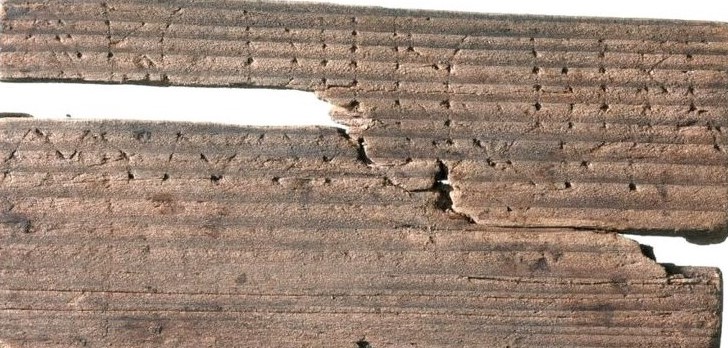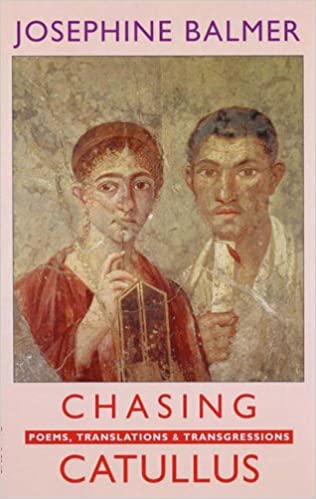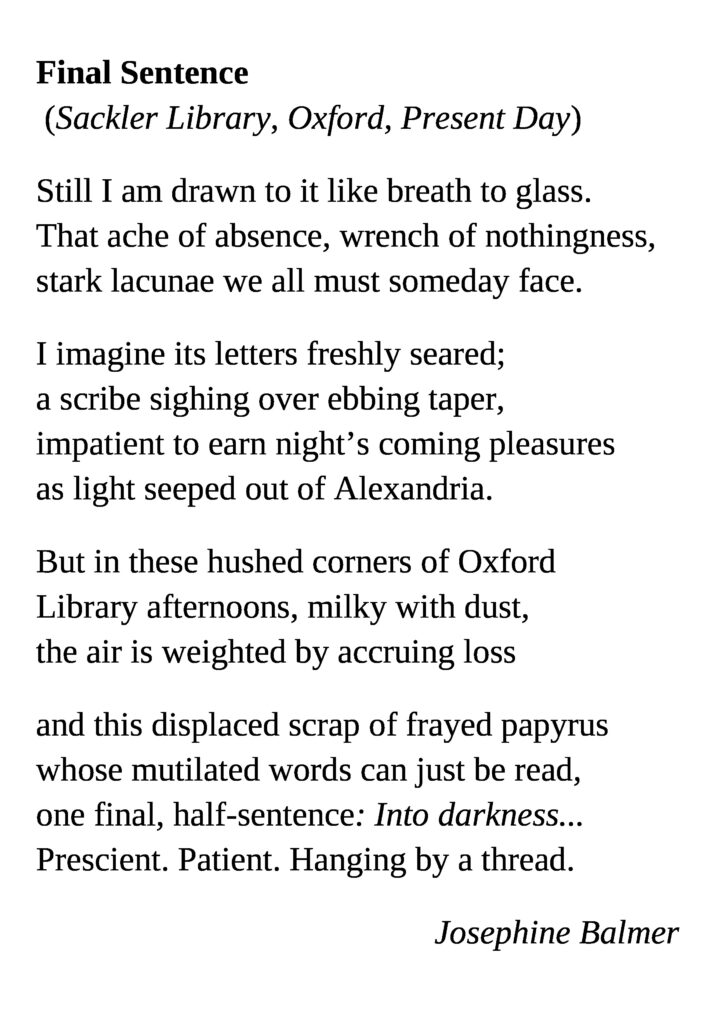
JANE BURN – POETRY AS HARD GRAFT, INSPIRATION, REACTION OR EXPERIMENT?
I interviewed poet & artist Jane Burn who won the Michael Marks Environmental Poet of the Year 2023-24 with A Thousand Miles from the Sea.

I interviewed Dr Josephine Balmer, acclaimed translator of Sappho, Catullus, Ovid and historian-poet whose investigative work looks deep into hidden aspects of classical culture. Josephine’s approach to the past is lyrical, deeply poetic and scholarly.
Josephine studied Classics and Ancient History at University College, London, and completed a PhD in Literature and Creative Writing at the University of East Anglia. Josephine has written for The Observer, The Independent on Sunday, The Times Literary Supplement, New Statesman and The Times, and has eight published volumes
Leslie: Many people think that accurate historical investigation and poetry are opposite disciplines. Why are they wrong? What first made you think of mixing the two? How did that idea grow and develop?
Josephine: Yes, I’m sure they do. But it’s clear that historians and archaeologists have more in common with poets than might at first appear. Both seek to uncover lost fragments of human existence, the detritus we leave behind, whether physical or emotional. Both forge connections between past and present, inevitably and inescapably reading that past in terms of our present. And where archaeology excavates beautiful, lost objects, long-buried in the accumulating silt of history, poetry excavates language, particularly image and metaphor, from the dusty inspiration of time and place. Both meticulously brush away the dirt to restore the colour and vibrancy to long-forgotten or discarded artefacts. Above all, both seek to reconstruct the tattered fragments. To rebuild the fallen cities. To give breath to the silent voices.
As for when and why I thought of merging the two disciplines, both have been part of my DNA since childhood – I read poetry from being a young child and was so obsessed with history my birthday treats were always a trip to the British Museum! – so it seemed a natural choice. I was, of course, also inspired by other poets for whom the past resonates through the present: TS Eliot’s Four Quartets, Seamus Heaney’s North and Field Work, Michael Longley’s Gorse Fires, and perhaps most of all the Greek Alexandrian poet CP Cavafy whose work I came to as a teenager through Lawrence Durrell’s The Alexandria Quartet and which immediately captivated.

But the concept really came to fruition while I was writing my first collection, Chasing Catullus: Poems, Translations and Transgressions, published in 2004. Its central section offered a response to the death of my young niece from cancer, a very difficult and private time for my family, especially my sister, which I found I could voice through the prism of classical texts. And so the distant past, and its poetry, became the vocabulary through which I could begin to say the unsayable. To approach events and emotions that might otherwise have been too distressing to articulate. As Chimamanda Ngozi Adichie said of the death of her father, at such times “you learn how much grief is about language, the failure of language and the grasping for language…” In Chasing Catullus I found my language through the myths and literature of the ancient world, juxtaposed throughout with original poems so that past grief and present trauma could each speak to the other.
Leslie: Why did you choose to translate, in particular, Sappho and Catullus? Given Ezra Pound’s influence on modern translation and Don Paterson’s idea of ‘versioning’, what’s the process you use to work on literature that has already been translated several times? How free and creative and how literal are your translations?
Josephine: These are all very good and legitimate questions to ask any translator but are actually quite hard to answer!
To take them one by one, I feel quite strongly that I didn’t choose Sappho but that her poetry chose me. I’d actually first come across her work as a young schoolgirl in a picture-strip story in the educational children’s comic Look and Learn (which even then I was reading second-hand after buying a pile of old issues at a jumble sale). I was so fascinated by the tale of an ancient Greek woman poet whose work had more and less vanished from history, I decided there and then to learn Greek in order to read what survived for myself. It wasn’t easy as Greek wasn’t taught in many schools and I had to persuade my Latin teacher to start a Greek class for a few of us I’d corralled into studying with me.
Then, when I started to study as a classics’ student at University College, London, Sappho’s work wasn’t on the syllabus. Translations were also very few and far between; Mary Barnard and Willis Barnstone’s American versions were available on import – I came across my copy of the former in Dillon’s University Bookhop by chance. I admired both very much – as I later did Anne Carson’s – but they weren’t necessarily ‘my’ Sappho. And so I decided to write my own versions to fill both a literary and a commercial gap.
As for Catullus, I began translating his poetry after a very intense period of working on women poets, first Sappho and then other ancient writers for my 1996 volume Classical Women Poets. His sometimes obscene, testosterone-fuelled poems were a big change of subject and tone but I enjoyed the challenge of translating (and subverting) his humour, and of working with a complete poem after so many fragments.
Retranslating such monolithic texts is not just a choice but a requirement, a cultural need, otherwise we would still be reading medieval versions that would need almost as much translation as the original. But one of the reasons you engage with a particular work is that you feel called to do it differently (rather than better) to previous translators of the work. So, again, I wanted to create ‘my’ Catullus – the wry, teasing Catullus I found in reading the texts and textual scholarship – which didn’t always chime with that of other translators. That said, as a translator your own intense relationship with the text itself, rather than any response to previous versions, lies at the heart of the task, although clearly every new translation transforms and enhances its afterlife. But when you are working on a text which has been translated and retranslated many times before you have to let those other voices become white noise, on the edge of hearing.
As for the question of fidelity and creativity, this is another thorny issue. Clearly it isn’t possible to be completely ‘literal’ otherwise the translated poem would be garbled, and certainly wouldn’t read as poetry. On the other hand, monolingual readers of any translations deserve the reassurance that they are as much ‘Sappho’ or ‘Catullus’ as you can reasonably manage. I’m talking here of translations that appear in a translation volume per se, rather than versions that might be included in a poetry collection (which, to me, do not differ in conception and creativity to ‘original’ poems). I defer to Anne Carson who said of her own (very radical) translations of Catullus: ‘my versions bear about the same relationship to translation as Francis Bacon’s paintings do to mug shots. He says they are very close…’
Leslie: Why did you intersperse versions of Ovid’s exile poems with the story of the old second-hand dictionary being used to translate them?
Josephine: Another good question! The concept of the book actually came about by accident. At first I had been thinking about another volume of translations. But then fate intervened. Working on Ovid’s Tristia during an electrical storm, I had to log off the online version of Lewis & Short’s Latin Dictionary, and turn instead to an old second-hand copy I’d bought as a student. As I did so, I noticed that its original owner had written his name on the flyleaf as a school boy in 1900. Later, when power was restored, I discovered – through the very scholarly act of a Google search – that this original owner had, as an adult, fought in the ill-fated First World War Gallipoli campaign, near to Ovid’s own place of exile at Tomis on the Black Sea. And so The Word for Sorrow moved into shape.
From these chance beginnings, I realised I could establish a dialogue between three parallel stories and times: Ovid’s exile in the first century CE, my soldier Geoffrey’s harrowing war experiences in the early twentieth century, and then, more and more, my own narrative in the twenty-first century as I uncovered the links between each one. In particular, I think the historical connections and layers offered a new way to approach the horrors of the First World War, giving a different perspective to the now universal literary tropes of writing about the conflict.
Leslie: Is a poem a jigsaw involving fine motor skills and laboriously ‘Piecing Together the Fragments’? Or is it a complex, interconnected organism that follows its own creative laws and springs to life in a leap of faith? Considering your own experience and what you’ve learned about other poets, what’s your take on this dichotomy?
Josephine: I think we all like to subscribe to the romantic concept of poetry as shamanistic, a possession, seizing the poet, as you say, Leslie, in a flash of inspiration. That does happen, of course. But like any other creative endeavour it is probably also 99% hard slog.
And here I think my training as a translator is very useful, as the processes for the two, translation and creativity, very definitely overlap. I find that any poem usually starts with a voice, whether my own or someone else’s. You hear their first line(s), and often the final one too. Working out how to get from one to the other is the hard part of the process. But it’s a bit like abstract art, you have to keep on working through until you know when to stop. And then, just as you think it’s an impossible task, something clicks into place and the ‘puzzle’ is solved – like doing a Wordle! That said, I am a terrible fiddler and tend to edit and reedit, probably when I should leave well alone – another habit I have picked up from translating…

Leslie: You have eight collections of your writing. Can you describe the genesis and subsequent development of ‘The Paths of Survival’? What did you learn from writing this book?
Josephine: Again, it was quite an organic process. I had been planning to work on Aeschylus’s lost tragic masterpiece Myrmidons for some time. Only ten small fragments now remain but the play had been notorious throughout antiquity, and beyond, for the way in which it portrayed the intense homoerotic relationship between the Greek warrior prince Achilles and his comrade Patroclus (a story Madeline Miller recently set at the heart of her 2011 novel The Song of Achilles). And, of course, this difficult reception could well have been the reason it didn’t make it through intact.
But when I started researching how Myrmidons had been fragmented – and rediscovered – over the centuries, I discovered its fascinating stories of loss and survival against all odds: a word from the play discovered in a remote Greek monastery; the tiny papyrus scrap thought destroyed in the Allied bombing of Florence before being rediscovered in a forgotten notebook transcript; a few words scrawled on the back of a legal note by a bored administrator from third-century BCE Egypt. I also loved the way the story extended from Athens to Alexandria, Byzantium to Baghdad, Syria to Spain, pushing the boundaries, quite literally, of what we might consider to be the ‘classical’ world.
Then, quite early on, I hit on the concept of moving backwards in time, starting with a tiny scrap of papyrus in a present day Oxford library and ending with Aeschylus revising his play on his deathbed in 456 BCE. Along the way, I wanted to explore the stories of all those who had been touched or influenced by the text – editors, archaeologists, soldiers, scribes, pagans, Christians and so on.
At first I was concerned that I had set myself an almost impossible task in making dry scholars or internecine religious disputes the subject of lyric poetry. But again, finding a voice proved crucial. And the more the characters spoke to me, often after extensive research, the more they stepped out of the shadows of obscurity to articulate the same emotions we all feel: loss, fear, love, anger, envy. And afterwards I was really encouraged by reactions to the collection from those readers who knew nothing of the play and had no interest at all in Greek textual scholarship. It seems the fear of a loss of culture is universal, as are the tiny victories that mitigate against it.
As for your question, Leslie, on what I learnt from writing the collection, that would be to trust in my own vision and keep going…
Next week Josephine Balmer describes about how she writes her books and why the past is a vital issue for us today.
ABOUT LESLIE TATE’S BOOKS:

I interviewed poet & artist Jane Burn who won the Michael Marks Environmental Poet of the Year 2023-24 with A Thousand Miles from the Sea.

I interviewed ex-broadcaster and poet Polly Oliver about oral and visual poetry, her compositional methods, and learning the Welsh language. Polly says, “I absolutely love

I interviewed Jo Howell who says about herself: “I’ve been a professional photographic artist since I left Uni in 2009. I am a cyanotype specialist.


Poet Tracey Rhys, writer of Teaching a Bird to Sing and winner of the Poetry Archive’s video competition reviews Ways To Be Equally Human. Tracey,
| Cookie | Duration | Description |
|---|---|---|
| cookielawinfo-checkbox-analytics | 11 months | This cookie is set by GDPR Cookie Consent plugin. The cookie is used to store the user consent for the cookies in the category "Analytics". |
| cookielawinfo-checkbox-functional | 11 months | The cookie is set by GDPR cookie consent to record the user consent for the cookies in the category "Functional". |
| cookielawinfo-checkbox-necessary | 11 months | This cookie is set by GDPR Cookie Consent plugin. The cookies is used to store the user consent for the cookies in the category "Necessary". |
| cookielawinfo-checkbox-others | 11 months | This cookie is set by GDPR Cookie Consent plugin. The cookie is used to store the user consent for the cookies in the category "Other. |
| cookielawinfo-checkbox-performance | 11 months | This cookie is set by GDPR Cookie Consent plugin. The cookie is used to store the user consent for the cookies in the category "Performance". |
| viewed_cookie_policy | 11 months | The cookie is set by the GDPR Cookie Consent plugin and is used to store whether or not user has consented to the use of cookies. It does not store any personal data. |
2 responses
This is wonderful. Thank you Leslie and Josephine!
🙂 🙂 🙂